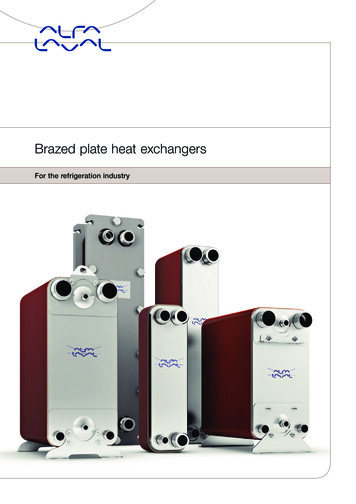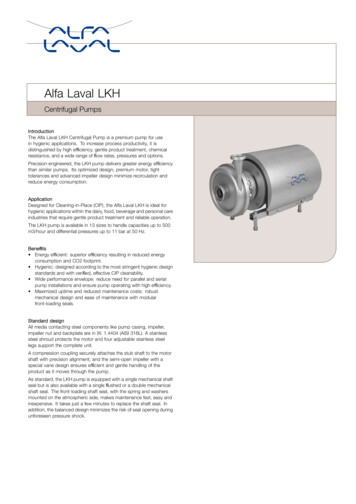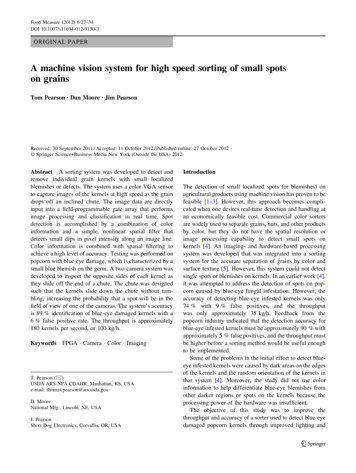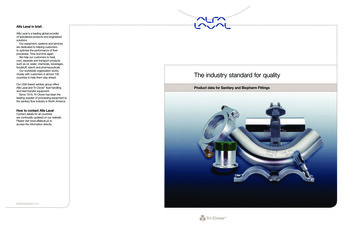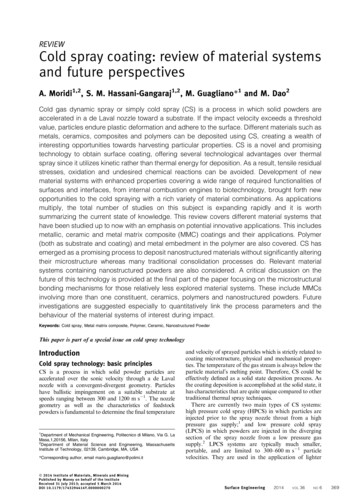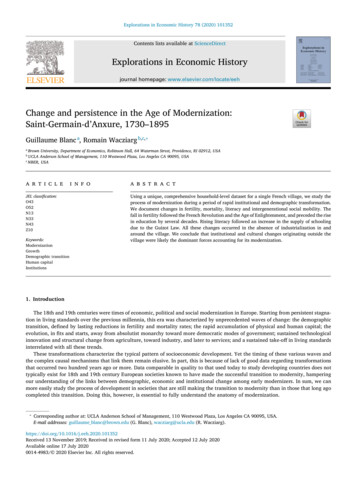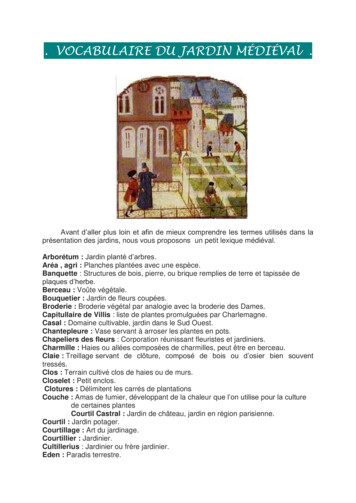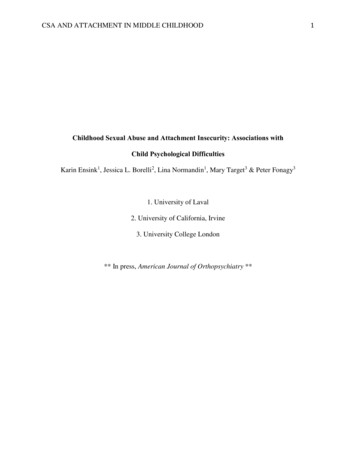
Transcription
CSA AND ATTACHMENT IN MIDDLE CHILDHOODChildhood Sexual Abuse and Attachment Insecurity: Associations withChild Psychological DifficultiesKarin Ensink1, Jessica L. Borelli2, Lina Normandin1, Mary Target3 & Peter Fonagy31. University of Laval2. University of California, Irvine3. University College London** In press, American Journal of Orthopsychiatry **1
CSA AND ATTACHMENT IN MIDDLE CHILDHOOD2AbstractAlthough research documents that childhood sexual abuse (CSA) and insecure attachment areassociated with psychopathology in children, to date no studies have delineated the unique andinteractive contributions of these two risk factors. The aims of this study were to examineattachment in sexually abused children and a comparison group and to assess the contributions ofeach risk factor to child psychological difficulties. Participants were 111 children aged 7-13, ofwhich 43 were CSA victims. In addition, in the service of enhancing understanding regardingCSA, we sought to compare among children experiencing different subtypes of CSA – childrenwhose abusers were members of the family (intrafamilial CSA) versus outside of the family(extrafamilial CSA). We anticipated that intrafamilial CSA would be associated with greaterpsychopathology risk given that it may involve disruption in children’s primary attachmentrelationships as well as trauma exposure. Children completed an attachment interview andreported on their depressive symptoms. Their mothers reported on children’s externalizingsymptoms, internalizing symptoms, dissociation, and sexualized behaviour. The findings indicatethat, as hypothesized, children with (intrafamilial or extrafamilial) CSA were more likely to beclassified as insecure and disorganized. In general, children experiencing intrafamilial CSAshowed the most compromised psychological adjustment, followed by children experiencingextrafamilial CSA and then the comparison group. More fine-grained analyses revealed that CSAhistory was uniquely associated with children’s externalizing problems, sexualizing problems,and dissociation, whereas insecure attachment was uniquely associated with child-reporteddepressive symptoms. Insecure attachment appeared to be protective for internalizing symptomsin the context of CSA, while generally associated with greater risk for psychopathology. Patternsof psychopathology symptoms differed among children exposed to intrafamilial CSA.Public Policy Relevance: Both childhood sexual abuse and insecure and particularlydisorganized attachment are associated with enhanced risk for psychopathology in childhood,
CSA AND ATTACHMENT IN MIDDLE CHILDHOODrendering treatment decision-making difficult for children presenting with multiple sources ofrisk. The findings of this study suggest that children presenting with sexual abuse histories aremore likely to have insecure or disorganized attachment. Further, when children haveexperienced CSA, particularly CSA that has been perpetrated by a family member, their risk forpsychopathology is higher regardless of attachment. Policy makers should prioritize theprevention or treatment of insecure/disorganized attachment among samples of non-abusedyouth, and the prevention or treatment of trauma-related symptoms among abused children.Keywords: sexual abuse, child attachment, depressive symptoms, externalizing,dissociation, sexualized behaviors3
CSA AND ATTACHMENT IN MIDDLE CHILDHOOD4Childhood Sexual Abuse and Attachment Insecurity: Associations withChildren’s PsychopathologyChildhood sexual abuse (CSA) confers risk for mental health difficulties across thelifecycle in 70-75% of victims (Trickett, Noll, & Putnam, 2011). Forty-to-sixty percent ofchildren affected by CSA experience psychological problems, including depressive symptoms,externalizing difficulties, sexualized behavior and dissociation (Collin-Vézina, Hébert, &Brabant, 2007; Ensink, Bégin, Normandin, Godbout, & Fonagy, 2016; Hébert, Tremblay, Parent,Daigneault, & Piché, 2006). However, not all children develop mental health difficultiesfollowing CSA, and little is known regarding potential protective processes such as attachment(Kwako, Noll Putnam, & Trickett, 2010). Trickett, Noll and Putnam (2011) argue that CSAactivates the child’s attachment system and need for comfort and security, suggesting thatchildren whose attachment figures are unreliable in their responsiveness may have moredifficulty coping following CSA, and thus be at greater risk for psychopathology. Put concretely,children survivors of CSA with insecure and disorganized attachment relationships may have thehighest risk of psychological maladjustment, whereas those with secure attachments may be ableto rely upon their relationships to support recovery from this trauma. Further, the impact of CSAon children may depend on the identity of the perpetrator of the abuse, which could be related tochildren’s attachment with primary caregivers and could also interact with children’s attachmentin predicting children’s outcomes. Presently, little is known regarding the relation between CSAand attachment in school-aged children and their association with psychological difficulties; inthe current investigation, by exploring psychopathology symptoms in CSA-exposed children anda comparison group, we seek to examine the contributions of children’s attachment to theprediction of psychological adjustment, differentiating between CSA perpetrated by personswithin and outside of the immediate family. Knowledge regarding the relative contributions ofeach of these risk factors to children’s psychological adjustment is crucial in guiding policy and
CSA AND ATTACHMENT IN MIDDLE CHILDHOOD5practice.AttachmentAttachment theory holds that children develop unconscious schemas of self and others,known as internal working models (IWMs) of attachment, based on the quality of early parentinfant interactions. The child’s resulting IWM guides thoughts, feelings, and behaviors in closerelationships throughout the life cycle (Bowlby, 1980; Bretherton, Ridgeway, & Cassidy, 1990;George & Solomon, 1996; Shaver, Collins, & Clark, 1996). When caregivers consistentlyprovide sensitive care, children develop secure IWMs, conceiving of close relationships asnurturing and of themselves as worthy of love (Bowlby, 1973). These children have the strongsense that they can depend on attachment figures for security when in distress. However, whencaregivers consistently or inconsistently reject or ignore their children’s bids for attention,children develop an insecure attachment pattern, comprised of the implicit sense that theavailability of others is conditional (Bowlby, 1973). Children with insecure-organizedattachments adopt either dismissing or preoccupied styles, in which they consistentlysuppress/deactivate or augment/hyperactivate the expression of their emotional needs,respectively (Cassidy, 1994).In contrast to organized patterns of attachment, disorganized attachment develops incontexts in which attachment figures behave in frightened, frightening, or role-reversed ways(Hesse & Main, 2006; Lyons-Ruth, Bronfman, & Parsons, 1999; Lyons-Ruth & Jacobvitz,2008). The resulting disorganization of attachment reflects an absence or collapse of strategy fordealing with attachment-related distress (Hesse & Main, 2000; Main & Solomon, 1990), thusincreasing risk of psychological difficulties. In middle childhood, researchers can measurechildren’s mental representations of attachment relationships using semi-structured interviews(e.g., the Child Attachment Interview [CAI]; Shmueli-Goetz, Target, Fonagy, & Datta, 2008); aninitial validity study of the CAI revealed that 66% of children have secure attachment
CSA AND ATTACHMENT IN MIDDLE CHILDHOOD6representations, 30% had organized-insecure representations, and 4% of which were classified ashaving disorganized attachment (see Privizzini, 2017, for a review).Attachment, Sexual Abuse and PsychopathologyFindings from meta-analyses show that both insecure-organized and disorganizedchildren have greater risk for concurrent and later internalizing difficulties (Colonnesi, Draijer,Stams, Van der Bruggen, Bögels, & Noom, 2011; Groh, Roisman, van IJzendoorn, BakersmansKranenberg, & Fearon, 2012; Kerns & Brumariu, 2014; Madigan, Atkinson, Laurin, & Benoit,2013), as well as aggressive and externalizing behaviors (Fearon, Bakermans-Kranenburg, vanIJzendoorn, Lapsley, & Roisman, 2010). Disorganized and dismissing attachment may also be anearly risk factor for later dissociation (Ogawa, Sroufe, Weinfield, Carlson, & Egeland, 1997),although all findings are not convergent (Hadigan & Roisman, 2015) and the link in middlechildhood may be indirect (Borelli, David, Crowley, & Mayes, 2010). In sum, attachmentinsecurity and disorganization are considered non-specific risk factors that increases the risk forproblems in combination with other factors (Kerns & Brumariu, 2014).With regard to the simple associations between CSA and attachment, preschool-agedchildren with CSA are more likely to be classified as having disorganized and preoccupiedattachment than non-victims (Fresno, Spencer, Ramos, & Pierrehumbert, 2014). Furthermore,disorganized attachment is more frequent among adolescents with CSA experiences than in adepressed comparison group and a non-depressed/non-abused comparison group (van Hoof, vanLang, Speekenbrink, van IJzendoorn, & Vermeiren, 2015).In addition to the simple associations between CSA exposure and insecure ordisorganized attachment with children’s psychopathology, there are compelling reasons tobelieve that these risk factors may interact in the prediction of clinical distress. Sharp, Fonagy,and Allen (2012) developed a theoretical model in which they argue that the social cognitionpatterns associated with attachment insecurity –perceptions of the self as unlovable and of others
CSA AND ATTACHMENT IN MIDDLE CHILDHOOD7as unavailable in times of need—predispose people to experience pathological reactions whenthey experience traumatic events. The key tenets of this theoretical model have been supported inpiecemeal in studies of general trauma exposure and post-traumatic stress disorder symptoms inadults and adolescents (e.g., Joubert, Webster, & Hackett, 2012), and one study found that socialcognitive deficits explained the longitudinal association between insecure attachment and posttraumatic stress disorder symptoms in adolescents (Venta, Hatkevitch, Mellick, Vanwoerden, &Sharp, 2016).In addition to the historical reasons why youth exposed to CSA may be more likely toexperience pathological reactions to the trauma (e.g., internalized mental representations of theself as unlovable/others as unavailable, Sharp et al., 2012), the current interpersonalenvironments of youth may vary significantly as a function of their attachment relationships withcaregivers. The occurrence of CSA is likely to activate children’s attachment systems (Trickett etal., 2011), resulting in the child needing more from his/her attachment figures. For instance, ifand when the child discloses CSA to caregivers, the parents of a secure child may be more likelyto react by validating their child’s experiences and increasing their psychological and physicalavailability to the child. In contrast, parents of insecure children may react by denying the eventor minimizing its purported emotional impact on the child; alternatively, they may becomeoverwhelmed or frightened. Both of these types of reactions may decrease the degree to whichthe parent can serve as an available support for the child, which may impact the degree to whichthe child can engage in the type of gradual emotional processing that could prevent pathologyfrom developing.Although these studies provide evidence suggestive that CSA and attachment may haveinteractive associations with children’s adjustment, to date few studies have explored these linksin pre-adolescent-aged youth and with respect to CSA in particular. However, the results of ahandful of studies of adults suggest that attachment security may protect against the negative
CSA AND ATTACHMENT IN MIDDLE CHILDHOOD8impact of sexual trauma on psychological adjustment (Aspelmeier, Elliott, & Smith, 2007) andthat attachment insecurity explains the association between sexual trauma and adjustment(Limke, Showers, & Zeigler-Hill, 2010; Roche, Runtz, & Hunter, 1999). One study to dateexamined the associations between attachment insecurity within a sample of preschoolers whohad been exposed to CSA, finding that within this population, insecurity conferred risk forinternalizing and externalizing difficulties (Zéphyr et al., 2015). To our knowledge, only a singlestudy has tested the contributions of both CSA and attachment to youth’s psychologicaladjustment; Jardin et al. found that among adolescents receiving inpatient psychiatric care,attachment security moderates the association between CSA and trauma symptoms (Jardin,Venta, Newlin, Ibarra, & Sharp, 2015), such that adolescents with insecure attachment and CSAexposure showed significantly greater trauma symptoms.Current InvestigationIn an attempt to build on the current knowledge base regarding attachment, CSA, andchildren’s adjustment, we explore a set of research questions within a sample of CSA-exposedschool-aged children and a comparison group. We test our hypotheses regarding theinterrelations of these constructs during a developmental period during which attachmentrelationships undergo dramatic shifts, moving from relationships in which physical presence ofthe caregiver is of the utmost importance to one in which caregivers’ central function is one ofproviding psychological, rather than physical, availability to children. This shift in relationalneeds is itself an important justification for studying these constructs during middle childhood,but there are additional compelling reasons to focus on this stage. For instance, middle childhoodis the developmental phase preceding the onset of increases in psychopathology as well asincreases in the importance of romantic relationships and sexual behaviour. Thus, in terms ofsensitive periods for the delivery of prevention or intervention efforts, middle childhood may bethe most important time in which to understand the links between sexual trauma, attachment, and
CSA AND ATTACHMENT IN MIDDLE CHILDHOOD9psychological adjustment. Programs effectively targeting children in this phase have the potentialto disrupt the link between CSA and sexual victimization in dating relationships (CITE).The primary aim of this study was to examine the association between attachment andCSA. The second aim was to examine the unique and interactive contributions of attachment andCSA in the prediction of child-reported depressive symptoms, as well as parent-reportedexternalizing symptoms, sexualized behavior, and dissociation in children. We hypothesized thatCSA victims would be more likely to have insecure attachment. Further, we anticipated that CSAand insecure attachment, as well as their interaction, would be associated with increased risk ofpsychological difficulties.In all analyses, we first tested the relationship between abuse and attachment measured asconstructs with two levels (CSA versus no CSA, secure versus insecure attachment). However,to exploit the richness of the current sample, we also explored associations using three-levelvariables (no CSA, extrafamilial CSA, and intrafamilial CSA; secure, insecure-organized,disorganized) – although the cell sizes for some of these groups (e.g., disorganized attachment)were small, we reasoned that providing this information may aid investigators in generatinghypotheses for subsequent investigations that have more statistical power. Further, to attempt toisolate the unique associations between these two risk factors and children’s adjustment, in allanalyses, we controlled for potentially confounding indices of psychosocial adversity.MethodThe protocol for this study was approved by the university ethics board. Parents providedinformed consent and children provided informed assent prior to participating in this study; theconsent/assent procedures involved informing youth and parents that they could refuse toparticipate in any portion of the study. Sexually abused children and their mothers were referredto the university clinic by doctors, social services, or mental health practitioners at communityhealth services and hospitals in the city and surrounding regions. The community comparison
CSA AND ATTACHMENT IN MIDDLE CHILDHOOD10group was recruited through advertisements at Community Health Services and schools throughpamphlets soliciting participation in a study on the impact of CSA as part of a comparison group.The comparison group was selected to broadly match the sociodemographic, age (within sixmonths), and gender characteristics of the abused group.The demographic features of the resulting sample are described in Table 1. More thanhalf (61.3%) of the participants were female and the average age of the participants was 9.53years (SD: 1.45 years), ranging between 7 years and 12 years. Reflecting the socio-demographicsof the region, most participants were Caucasian (98%). Assessments took place at a universitychild and adolescent consultation service. Parents received a modest stipend to cover transportcosts and children were invited to choose a toy or small gift.MeasuresChildren’s Abuse History. Information regarding CSA was based on medical andsocial work reports and information from police inquiries, including statements of admission bythe abuser. Parents of comparison group children were interviewed about the child’sdevelopmental history and traumatic life events to ensure comparison sample children did nothave CSA histories. We classified children into three groupings (no CSA history, extrafamilialCSA history, and intrafamilial CSA history), where intra-familial abuse referred to abuse bymembers of the immediate family such as a father, father-figure (including the mother’s partner),a grandparent, or a sibling.Child Attachment. The Child Attachment Interview (Shmueli-Goetz et al., 2004) is asemi-structured interview assessing children’s attachment representations of their currentrelationships with their primary caregivers. The interview is similar in format, scope andtheoretical underpinnings to that employed in the Adult Attachment Interview (George, Kaplan,& Main, 1985), but all of these elements of assessing attachment representations aredevelopmentally scaled for measurement in middle childhood (ages 7 to 12). Children are asked
CSA AND ATTACHMENT IN MIDDLE CHILDHOOD11to describe their relationships with their primary caregivers and to support their descriptions byproviding examples of concrete relationship episodes. Trained CAI coders rate the CAI usingboth verbatim transcripts of CAI narratives and videotapes using ten 9-point scales capturingdifferent aspects of security (e.g., emotional openness, preoccupied anger, idealization, narrativecoherence). Based on these scales, coders assign children to one of four attachment categorieswith respect to each parent: secure, dismissing, preoccupied, and disorganized. In prior studies,most children with two caregivers receive the same classification for both (e.g., Shmueli-Goetzet al., 2008).The CAI demonstrates concurrent validity in community, clinical, and CSA samples(Borelli et al., 2016a, 2016b; Ensink et al., 2016a; Ensink, Bégin, Normandin & Fonagy, 2016b;Ensink et al., 2015; Scott, Briskman, Woolgar, Humayun, & O’Connor, 2011; Scott et al., 2011;Shmueli-Goetz et al., 2008; Target et al., 2003; Venta, Shmueli-Goetz, & Sharp, 2014), andinter-rater reliability among expert and “naïve” coders is acceptable (e.g., Shmueli-Goetz et al.,2008; see Privizzini, 2017, for a review). In this study, the first author trained two students tocode 30 transcripts. The remainder of the transcripts were double coded, and where there wascoder disagreement, the first author recoded the transcript and a consensus decision was reachedafter clarifying and examining reasons for lack of agreement: 4-way classification: Kappa .91,p .001).Children’s depressive symptoms. Children completed the Children’s DepressionInventory (CDI; Kovacs, 1992), an assessment of depressive symptoms in school-aged children.On this 27-item, psychometrically strong measure (Romano & Nelson, 1988), children selectwhich of a series of statements describe them best over the past two weeks (e.g., I am sad once ina while, I am sad many times, I am sad all of the time); higher scores signify more severesymptoms. The CDI includes items indexing recent depressive symptoms in behavioral,cognitive, affective, and physiological domains. Internal consistency was good, α .86.
CSA AND ATTACHMENT IN MIDDLE CHILDHOOD12Children’s Behavior Difficulties. The Child Behavior Checklist (CBCL) is a 118-itemquestionnaire used to assess a broad range of internalizing and externalizing difficulties(Achenbach, 1991). In the present study, we used the parent report internalizing andexternalizing scale for children aged 6–18 (Achenbach & Rescorla, 2001). Parents rate behavioron a three-point scale as 0 (absent), 1 (occurs sometimes), or 2 (occurs often) for items such as,“breaks rules at home, school, or elsewhere”. The CBCL has been demonstrated to have goodpsychometric properties (Achenbach & Rescorla, 2001). Cronbach’s alphas indicatedsatisfactory internal consistency in the current study (α ranged between .87 and .92).Children’s Dissociative Symptoms. The Child Dissociative Checklist (CDC) is a 20item questionnaire developed by Putnam (1990) as a parent-report measure of dissociativesymptoms during the past 12 months, created for children aged 5-12. Dissociative symptoms arerated on a 3-point Likert scale; total scores of 12 or above are considered indicative of clinicallysignificant dissociative symptoms. For example, parents are asked to rate items such as “Childgoes into a daze or trance-like state at times or often appears ‘spaced-out” and “Teachers mayreport that he or she ‘daydreams’ frequently in school.” The CDC demonstrates internalconsistency across all studied populations studied (i.e control, sexually abused, dissociativedisorder, multiple personality disorder) with Cronbach’s alphas ranging from .64 to .91 and .95for the sample as a whole. It is also considered to have high discriminant validity and good testretest reliability (Putnam, Helmers & Trickett, 1993).Children’s Sexualized Behavior. The Child Sexualized Behavior Inventory (SBI;Friedrich et al., 2001) is a 35-item parent report behavior checklist assessing sexual behavior inchildren between two and 12 years old during the previous 6 months. It covers nine domains,including boundary issues, sexual interest, exhibitionism, sexual intrusiveness, gender rolebehavior, sexual knowledge, self-stimulation, voyeuristic behavior and sexual anxiety. Each itemis rated on a 4-point scale from 0 (never) to 4 (at least once a week). The CSBI has been
CSA AND ATTACHMENT IN MIDDLE CHILDHOOD13demonstrated to have good psychometric properties including item-total correlations and testretest reliability (Friedrich et al., 2001). Total scores are converted to t-scores and t-scores above65 are considered indicative of clinically significant problems (Friedrich et al., 2001).Cronbach’s alphas were satisfactory in the current study, α .90.Covariates.Stressful events. Parents completed the Life Events Record (Coddington, 1972), whichasks participants to respond by stating whether a series of negative and positive life events (e.g.,death of a close friend, outstanding personal achievement) have occurred in the past year (i.e.,by providing a yes/no response). There exists multiple different versions of this questionnaire forassessing stressful life events exposure in different age groups of children; the version developedfor elementary aged children contains 35 items and was initially validated among a large sample(N 887). Scoring this measure involves using “life change units,” previously assigned to eachevent by panels of experts, that signify the amount of life change that is required to adjust to theevent, which is designed to account for the fact that some events require greater reorganizationthan others (e.g., beginning another school year 27 life change events, versus birth of a babybrother or sister 50 life change events). In Coddington’s original validity study of thismeasure, the average number of life events during a year for elementary aged children was 2.63and the average number of life change units was 102.80.Family income. Mothers reported whether their annual household income was below orabove 25,000 per year.Data Analytic PlanTo examine the association between attachment and CSA history, we conducted PearsonChi-Square Analyses. To examine both main and interactive effects of the multi-categoricalattachment and CSA history variables on children’s psychological adjustment, we conductedmultivariate analyses of covariance (MANCOVAs) —the use of this analysis enabled us to
CSA AND ATTACHMENT IN MIDDLE CHILDHOOD14control for confounds and to include all dependent measures in a single analysis, whileprotecting against multicollinearity. MANCOVAs generate overall F statistics for thecontribution of each independent variable and covariate to the broad set of dependent variables.In addition, we followed these MANCOVAs with Roy-Bargmann step-down analyses, whichenabled us to ascertain the specific contributions of each predictor variable to each dependentvariable after controlling for the other dependent variable. All analyses were conducted using thetwo-level abuse variable (no CSA versus CSA) and the two-level attachment variable (secure,insecure). These simpler analyses were followed with analyses involving the three-level abusevariable (no CSA, extrafamilial CSA, intrafamilial CSA) and the three-level attachment variable(secure, insecure-organized, disorganized). Due to the smaller sample size in the three-groupCSA and attachment analyses, we encourage researchers to rely most on the two-group analyses.However, we provide the three-group analyses given the paucity of research on this topic and thedifficulty of finding these low frequency participants (children with disorganized attachment andchildren with intrafamilial abuse).ResultsDescriptive statistics for all key study variables are reported in Table 1. Preliminaryanalyses indicated that all of the clinical measures were positively intercorrelated. Children’s ageand gender were not significantly associated with the clinical dependent variables in the study(see Table 1); and thus were not used as covariates in analyses.Less than half (40%) of the sample had experienced CSA, of which approximately halfhad experienced intrafamilial CSA. Of the 20% who had experienced intrafamilial CSA, 60%had been abused by their fathers, 18% by a step-parent, and 22% by a sibling. Of those who hadexperienced extrafamilial CSA, some had been abused by a member of the extended family(33%), while the rest had been abused by an acquaintance (67%). In addition, approximately50% of the children were classified as having secure attachment, 41% were classified as having
CSA AND ATTACHMENT IN MIDDLE CHILDHOOD15insecure-organized attachment (21% classified as dismissing, 20% preoccupied), and 8% withdisorganized attachment.Of the sample of CSA-exposed children, 18.2% experienced CSA on one occasion, 36%experienced four or more CSA incidents, and the remainder experienced CSA on two or threeoccasions. About half (54%) first experienced CSA before 48 months of age. Approximately half(55%) of the youth denounced the CSA; in the remainder of cases, parents (mother: 19%, father:3%) or other family members (23%) denounced the abuse. A minority (23%) of the children hadvaginal or anal penetration with a penis or object and experienced violent abuse (5%, but notethat it was impossible to determine whether violence occurred for 21% of the CSA-exposedsample).Of the children exposed to intrafamilial-CSA, 43% had CSA perpetrated by the father,14% by both parents, 19% by a sibling, and the remainder by step-parents or acquaintances; 64%of children exposed to intrafamilial CSA self-denounced the abuse and 50% were exposed toCSA before 36 months of age.Analyses of variance (ANOVAs) revealed that family income differed among thedifferent abuse groups, F(5, 109) 3.22, p .04, such that children in the non-abused group hadparents who reported significantly higher family incomes than children in the intrafamilial CSAgroup, p .02. Stress exposure was not significantly different among the abuse groups, F(5, 109) 2.66, p .08. Further, both family income, F(5, 109) 6.68, p .002, and children’s stressexposure, F(5, 109) 4.67, p .01, differed as a function of children’s attachment. With respectto family income, children classified as disorganized had lower family income than children withsecure, p .001, and insecure-organized attachment, p .02. With respect to children’s sexexposure, secure children reported significantly lower stressful life events than childrenclassified as either insecure-organized, p .03, or disorganized, p .01.Hypothesis Testing
CSA AND ATTACHMENT IN MIDDLE CHILDHOOD16Association between childhood sexual abuse and attachment.CSA versus no CSA. First we examined whether abuse history (CSA versus no CSA) wasassociated with children’s attachment classifications (secure versus insecure). Results of aPearson Chi-Square indicated that children’s abuse history was significantly associated with theirattachment classification, 2(2) 14.27, p .001. Children with insecure attachment were morelikely to have histories of CSA than secure children.Next we explored differences in subgroups of insecure attachment, examining secure,insecure-organized, and disorganized attachmen
Insecure attachment appeared to be protective for internalizing symptoms in the context of CSA, while generally associated with greater risk for psychopathology. Patterns of psychopathology symptoms differed among children exposed to intrafamilial CSA. Public Policy Relevance: Both childhood sexual abuse and insecure and particularly
